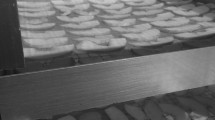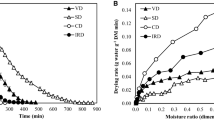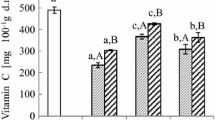Abstract
Food loss and malnutrition are critical aspects of modern society and a source of concern especially in developing countries, such as East Africa. The aim of the work was to provide an eco-sustainable solution to both problems, using an economical and green technology, such as solar drying. In the present work two cheap and efficient solar dryers, based on an innovative mild technology, were used for the valorisation of papaya fruit. A total of seven drying experiments on papaya and papaya seeds were performed to produce fruit-based ingredients with an improved shelf life. The obtained produces showed microbiological safety, with aw values lower than 0.55, stability over time (at least 2 months) and appreciable colorimetric characteristics. The dried products were used for the production of a functional food intended to improve the nutritional and health status of school-age children. The fruit meals have been used for their fiber and important phytochemicals contents, while papaya seeds have been included for their anthelmintic activity. The appreciation rate of the proposed food by the students (95%) suggested the possibility of its easy inclusion in the school menu. The proposed approach could be a promising tool of managing food loss and malnutrition in Developing Countries such as Tanzania, by increasing the shelf life of perishable products providing nutritious foods. This perspective meets the goals «Zero Hunger» and «Responsible Consumption and Production» included in the Sustainable Development Goals drawn up by the United Nations Member States.







Similar content being viewed by others
References
The 17 Goals (2015) United Nations. https://sdgs.un.org/goals. Accessed 6 July 2021
The Sustainable Development Goals Report 2020 (2020) United Nations. https://sdgs.un.org/sites/default/files/2020-09/The-Sustainable-Development-Goals-Report-2020.pdf. Accessed 6 July 2021
de La O Campos AP, Villani C, Davis B, Takagi M (2018) Ending extreme poverty in rural areas—sustaining livelihoods to leave no one behind, Rome. https://www.fao.org/3/ca1908en/CA1908EN.pdf. Accessed 6 July 2021
Ochieng J, Afari-Sefa V, Lukumay PJ, Dubois T (2017) Determinants of dietary diversity and the potential role of men in improving household nutrition in Tanzania. PLoS ONE 12:e0189022. https://doi.org/10.1371/journal.pone.0189022
Ssemwanga M, Makule E, Kayondo S (2020) The effect of traditional and improved solar drying methods on the sensory quality and nutritional composition of fruits: a case of mangoes and pineapples. Heliyon 6:e04163. https://doi.org/10.1016/j.heliyon.2020.e04163
Mongi RJ, Ndabikunze BK, Wicklund T, Chove LM, Chove BE (2015) Effect of solar drying methods on total phenolic contents and antioxidant activity of commonly consumed fruits and vegetable (mango, banana, pineapple and tomato) in Tanzania. Afr J Food Sci 9:291–300. https://doi.org/10.5897/AJFS2015.1232
de Oliveira JG, Vitória AP (2011) Papaya: nutritional and pharmacological characterization, and quality loss due to physiological disorders. An overview. Food Res Int 44:1306–1313. https://doi.org/10.1016/j.foodres.2010.12.035
Gayosso-García Sancho LE, Yahia EM, González GA (2011) Identification and quantification of phenols. carotenoids and vitamin C from papaya (Carica papaya L. cv. Maradol) fruit determined by HPLC-DAD-MS/MS-ESI. Food Res Int 44:1284–1291. https://doi.org/10.1016/j.foodres.2010.12.001
Cheenkachorn K, Jintanatham P, Rattanaprapa S (2012) Drying of papaya (Carica papaya L.) using a microwave-vacuum dryer. Int J Food Sci Nutr 6:793–797. https://doi.org/10.5281/zenodo.1328428
Chandra A, Kumar S, Tarafdar A, Nema PK (2021) Ultrasonic and osmotic pretreatments followed by convective and vacuum drying of papaya slices. J Sci Food Agric 101:2264–2272. https://doi.org/10.1002/jsfa.10847
Vega-Gálvez A, Uribe E, Poblete J, García V, Pastén A, Aguilera LE, Stucken K (2021) Comparative study of dehydrated papaya (Vasconcellea pubescens) by different drying methods: quality attributes and effects on cells viability. J Food Meas Charact 15:2524–2530
Vega-Gálvez A, Stucken K, Cantuarias C, Lamas F, García V, Pastén A (2021) Antimicrobial properties of papaya (Vasconcellea pubescens) subjected to low-temperature vacuum dehydration. Innov Food Sci Emerg Technol 67:102563. https://doi.org/10.1016/j.ifset.2020.102563
Chai HY, Yusup S, Ruslan SHM (2020) Review of bioactive compounds extracted from Carica papaya linn. Curr Nutr Food Sci 16:1287–1298
Islam MdR, Haque AR, Kabir MdR, Hasan MdM, Khushe KJ, Hasan SMK (2021) Fruit by-products: the potential natural sources of antioxidants and α-glucosidase inhibitors. J Food Sci Technol 58:1715–1726. https://doi.org/10.1007/s13197-020-04681-2
Silva JS, Ortiz DW, Garcia LGC, Asquieri ER, Becker FS, Damiani C (2020) Effect of drying on nutritional composition, antioxidant capacity and bioactive compounds of fruits co-products. Food Sci Technol 40:810–816. https://doi.org/10.1590/fst.21419
Kumoro AC, Alhanif M, Wardhani DH (2020) A critical review on tropical fruits seeds as prospective sources of nutritional and bioactive compounds for functional foods development: a case of indonesian exotic fruits. Int J Food Sci 2020:1–15. https://doi.org/10.1155/2020/4051475
Sugiharto S (2020) Papaya (Carica papaya L.) seed as a potent functional feedstuff for poultry—a review. Vet World 13:1613–1619. https://doi.org/10.14202/vetworld.2020.1613-1619
Adesuyi AO, Ipinmoroti KO (2011) The nutritional and functional properties of the seed flour varieties of Carica papaya. Curr Res Chem 3:70–75. https://doi.org/10.3923/crc.2011.70.75
dos Santos CM, de Abreu CMP, Freire JM, Queiroz ER, Mendonça MM (2014) Chemical characterization of the flour of peel and seed from two papaya cultivars. Food Sci Technol (Campinas) 34:353–357. https://doi.org/10.1590/fst.2014.0048
El-Safy FS, Salem RH, Abd El-Ghany ME 2012 Chemical and nutritional evaluation of different seed flours as novel sources of protein. World Dairy Food Sci 7:59–65. https://www.idosi.org/wjdfs/wjdfs7(1)/7.pdf
Okeniyi JAO, Ogunlesi TA, Oyelami OA, Adeyemi LA (2007) Effectiveness of dried Carica papaya seeds against human intestinal parasitosis: a pilot study. J Med Food 10:194–196. https://doi.org/10.1089/jmf.2005.065
Kermanshai R, McCarry BE, Rosenfeld J, Summers PS, Weretilnyk EA, Sorger GJ (2001) Benzyl isothiocyanate is the chief or sole anthelmintic in papaya seed extracts. Phytochemistry 57:427–435. https://doi.org/10.1016/S0031-9422(01)00077-2
Tona L, Kambu K, Ngimbi N, Cimanga K, Vlietinck AJ (1998) Antiamoebic and phytochemical screening of some Congolese medicinal plants. J Ethnopharmacol 61:57–65. https://doi.org/10.1016/S0378-8741(98)00015-4
Kugo M, Keter L, Maiyo A, Kinyua J, Ndemwa P, Maina G, Otieno P, Songok EM (2018) Fortification of Carica papaya fruit seeds to school meal snacks may aid Africa mass deworming programs: a preliminary survey. BMC Complement Altern Med 18:327. https://doi.org/10.1186/s12906-018-2379-2
Galanakis CM, Aldawoud TMS, Rizou M, Rowan NJ, Ibrahim SA (2020) Food ingredients and active compounds against the coronavirus disease (COVID-19) pandemic: a comprehensive review. Foods 9:1701. https://doi.org/10.3390/foods9111701
Galanakis CM, Rizou M, Aldawoud TMS, Ucak I, Rowan NJ (2021) Innovations and technology disruptions in the food sector within the COVID-19 pandemic and post-lockdown era. Trends Food Sci Technol 110:193–200
Galanakis CM (2020) The food systems in the era of the coronavirus (COVID-19) pandemic crisis. Foods 9:523. https://doi.org/10.3390/foods9040523
Mathlouthi M (2003) In: Caballero B, Finglas P, Toldrá F (ed) Encyclopedia of Food Sciences and Nutrition, 2nd edn. Academic Press, New York. https://doi.org/10.1016/B0-12-227055-X/00369-2
Marinoni L, Stellari A, Cattaneo TMP (2021) A mild and innovative solar drying process to provide high quality products. J Food Meas Charact. https://doi.org/10.1007/s11694-021-01191-3
G-teK (2016) Italo base+© User Manual. G-teK srl, Modena
G-teK (2018) ZefiroMAX+©. G-teK srl, Modena
Bennamoun L (2013) Integration of photovoltaic cells in solar drying systems. Dry Technol 31:1284–1296. https://doi.org/10.1080/07373937.2013.788510
AOAC (1995) Official Methods of Analysis of the Association of Official Analytical Chemists, Vol II, 16th edn. AOAC, Arlington
Wrolstad RE, Smith DE (2010). In: Nielsen S (ed) Food analysis, 4th edn. Springer, New York
Gurtler JB, Doyle MP, Kornacki JL (2014) The microbiological safety of low water activity foods and spices. Springer, New York. https://doi.org/10.1007/978-1-4939-2062-4
Abano EE, Sam-Amoah LK, Owusu J, Engmann FN (2013) Effects of ascorbic acid, salt, lemon juice, and honey on drying kinetics and sensory characteristic of dried mango. Croat J Food Sci Technol 5:1–10
Janjai S, Lamlert N, Intawee P, Mahayothee B, Boonrod Y, Haewsungcharern M, Bala BK, Nagle M, Müller J (2009) Solar drying of peeled longan using a side loading type solar tunnel dryer: experimental and simulated performance. Dry Technol 27:595–605. https://doi.org/10.1080/07373930802716383
Vega-Gálvez A, Poblete J, Quispe-Fuentes I, Uribe E, Bilbao-Sainz C, Pastén A (2019) Chemical and bioactive characterization of papaya (Vasconcellea pubescens) under different drying technologies: Evaluation of antioxidant and antidiabetic potential. J Food Meas Charact 13:1980–1990. https://doi.org/10.1007/s11694-019-00117-4
Garcia CC, Caetano LC, de Souza SK, Mauro MA (2014) Influence of edible coating on the drying and quality of papaya (Carica papaya). Food Bioproc Tech 7:2828–2839. https://doi.org/10.1007/s11947-014-1350-6
Puangsri T, Abdulkarim SM, Ghazali HM (2005) Properties of Carica papaya L. (papaya) seed oil following extractions using solvent and aqueous enzymatic methods. J Food Lipids 12:62–76. https://doi.org/10.1111/j.1745-4522.2005.00006.x
Sablani SS (2006) Food quality attributes in drying. Stewart Postharvest Rev 2:1–6. https://doi.org/10.2212/spr.2006.2.8
Barbosa-Canovas VG, Fontana JA Jr, Schmidt JS, Labuza PT (2007) Water activity in foods—fundamentals and applications. Blackwell, London
Samoticha J, Wojdyło A, Lech K (2016) The influence of different the drying methods on chemical composition and antioxidant activity in chokeberries. LWT - Food Sci Technol 6:484–489. https://doi.org/10.1016/j.lwt.2015.10.073
Ocoró-Zamora MU, Ayala-Aponte AA (2013) Influence of thickness on the drying of papaya puree (Carica papaya L.) Through refractance windowTM technology. Dyna 80:147–154
Reis RC, de Souza VE, da Silva SCS, de Oliveira Mamede ME, da Silva Araújo ÍM (2018) Stability and sensory quality of dried papaya. Food Nutr Sci 9:489–501. https://doi.org/10.4236/fns.2018.95038
Udomkun P, Nagle M, Argyropoulos D, Mahayothee B, Latif S, Müller J (2016) Compositional and functional dynamics of dried papaya as affected by storage time and packaging material. Food Chem 196:712–719. https://doi.org/10.1016/j.foodchem.2015.09.103
Walsh KB, Blasco J, Zuze-Sasse M, Sun X (2020) Visible-NIR ‘point’ spectroscopy in postharvest fruit and vegetable assessment: the science behind three decades of commercial use. Postharvest Biol Tech 168:111246. https://doi.org/10.1016/j.postharvbio.2020.111246
Toledo-Martín EM, García-García MC, Font R, Moreno-Rojas JM, Gómez P, Salinas-Navarro M, Del Río-Celestino M (2016) Application of visible/near-infrared reflectance spectroscopy for predicting internal and external quality in pepper: Estimation of quality in pepper by NIR spectroscopy. J Sci Food Agric 96:3114–3125. https://doi.org/10.1002/jsfa.7488
Nwofia GE, Ojimelukwe P, Eji C (2012) Chemical composition of leaves, fruit pulp and seeds in some Carica papaya (L.) morphotypes. J Medicinal Aromat Plants 2:200–206
Ordoñez-Santos LE, Ledezma-Realpe DP (2013) Lycopene concentration and physico-chemical properties of tropical fruits. Food Nutr Sci 4:758–762. https://doi.org/10.4236/fns.2013.47097
Acharya UK, Subedi PP, Walsh KB (2017) Robustness of tomato quality evaluation using a portable Vis-SWNIRS for dry matter and colour. Int J Anal Chem 2017:1–8. https://doi.org/10.1155/2017/2863454
Ishigaki M, Meksiarun P, Kitahama Y, Zhang L, Hashimoto H, Genkawa T, Ozaki Y (2017) Unveiling the aggregation of lycopene in vitro and in vivo: UV–Vis, resonance raman, and raman imaging studies. J Phys Chem 121:8046–8057. https://doi.org/10.1021/acs.jpcb.7b04814
Vega-Gálvez A, Poblete J, Rojas-Carmona R, Uribe E, Pastén A, Goñi MG (2021) Vacuum drying of Chilean papaya (Vasconcellea pubescens) fruit pulp: effect of drying temperature on kinetics and quality parameters. J Food Sci Technol 58:3482–3492. https://doi.org/10.1007/s13197-021-05005-8
Minuye M, Getachew P, Laillou A, Chitekwe S, Baye K (2021) Effects of different drying methods and ascorbic acid pretreatment on carotenoids and polyphenols of papaya fruit in Ethiopia. Food Sci Nutr 9:3346–3353. https://doi.org/10.1002/fsn3.2324
da Silva Júnior EV, Melo LL, Medeiros RAB, Barros ZMP, Azoubel PM (2018) Influence of ultrasound and vacuum assisted drying on papaya quality parameters. LWT Food Sci Technol 97:317–322. https://doi.org/10.1016/j.lwt.2018.07.017
Nimmanpipug N, Therdthai N (2013) Effect of osmotic dehydration time on hot air drying and microwave vacuum drying of papaya. Food Appl Biosci J 1:1–10. https://doi.org/10.14456/fabj.2013.1
Chong CH, Law CL, Figiel A, Wojdyło A, Oziembłowski M (2013) Colour, phenolic content and antioxidant capacity of some fruits dehydrated by a combination of different methods. Food Chem 141:3889–3896. https://doi.org/10.1016/j.foodchem.2013.06.042
Udomkun P, Argyropoulos D, Nagle M, Mahayothee B, Müller J (2015) Sorption behaviour of papayas as affected by compositional and structural alterations from osmotic pretreatment and drying. J Food Eng 157:14–23. https://doi.org/10.1016/j.jfoodeng.2015.01.022
Acknowledgements
The authors thank the community of monks of the Mvinwa Abbey and in particular Abbot Pambo and Father Lawrence for their support and collaboration.
Funding
This research did not receive any specific Grant from funding agencies in the public, commercial, or not-for-profit sectors.
Author information
Authors and Affiliations
Corresponding author
Ethics declarations
Conflict of interest
The authors declare no conflicts of interest for this article.
Additional information
Publisher's Note
Springer Nature remains neutral with regard to jurisdictional claims in published maps and institutional affiliations.
Rights and permissions
About this article
Cite this article
Pacifico, I., De Gara, L., Stellari, A. et al. The application of solar drying process for the valorisation of papaya fruit. Eur Food Res Technol 248, 857–867 (2022). https://doi.org/10.1007/s00217-021-03932-6
Received:
Revised:
Accepted:
Published:
Issue Date:
DOI: https://doi.org/10.1007/s00217-021-03932-6




